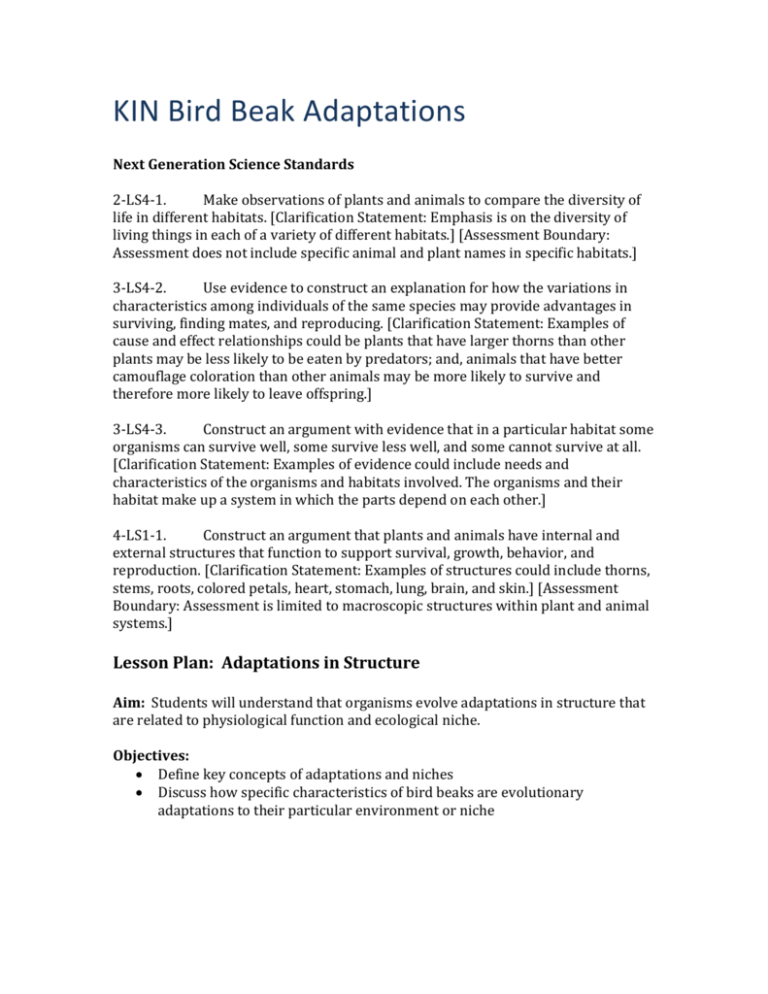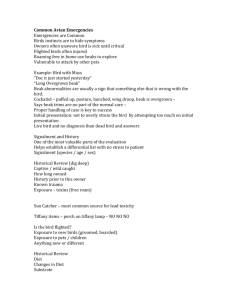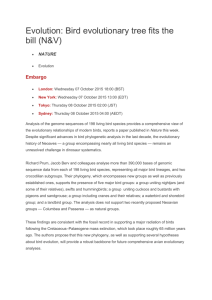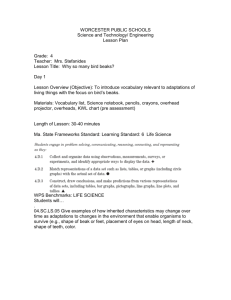Bird Beaks Lesson Plan
advertisement

KIN Bird Beak Adaptations Next Generation Science Standards 2-LS4-1. Make observations of plants and animals to compare the diversity of life in different habitats. [Clarification Statement: Emphasis is on the diversity of living things in each of a variety of different habitats.] [Assessment Boundary: Assessment does not include specific animal and plant names in specific habitats.] 3-LS4-2. Use evidence to construct an explanation for how the variations in characteristics among individuals of the same species may provide advantages in surviving, finding mates, and reproducing. [Clarification Statement: Examples of cause and effect relationships could be plants that have larger thorns than other plants may be less likely to be eaten by predators; and, animals that have better camouflage coloration than other animals may be more likely to survive and therefore more likely to leave offspring.] 3-LS4-3. Construct an argument with evidence that in a particular habitat some organisms can survive well, some survive less well, and some cannot survive at all. [Clarification Statement: Examples of evidence could include needs and characteristics of the organisms and habitats involved. The organisms and their habitat make up a system in which the parts depend on each other.] 4-LS1-1. Construct an argument that plants and animals have internal and external structures that function to support survival, growth, behavior, and reproduction. [Clarification Statement: Examples of structures could include thorns, stems, roots, colored petals, heart, stomach, lung, brain, and skin.] [Assessment Boundary: Assessment is limited to macroscopic structures within plant and animal systems.] Lesson Plan: Adaptations in Structure Aim: Students will understand that organisms evolve adaptations in structure that are related to physiological function and ecological niche. Objectives: Define key concepts of adaptations and niches Discuss how specific characteristics of bird beaks are evolutionary adaptations to their particular environment or niche Materials: Tools that represent various bird beaks; hammer, large pliers, small pliers, needle nose pliers, small wire cutter, chop sticks, tweezers, straw, knife or scissors, etc. Various bird foods or representations of; nuts, fruits, meat, leather, bird seed, liquid to simulate nectar, a container of beach sand and something to simulate beach invertebrates in the sand, etc. Laminated bird photos for Bird Bill Game If available- bird specimens Preparation: Have tools and photos or specimens visible to students on a table. Introduction: Why do birds have such varying morphology, or shape of bills? Birds do not have teeth, hands, paws, antlers, etc. They rely on their beaks for gathering or capturing food. The shape of a bird’s bill is often an adaptation to a particular diet or other behavior, e.g. making a hole in a tree for a home. Can we determine what type of food a species of bird eats by looking at the shape of the bill? Procedure: Have students try to match the bird specimen or photo to the representations of food by attempting to use the various tools to access the various foods, e.g. cracking open the nuts, drinking liquid, probing sand, reaching into a small hole etc. What tools work best for which foods? What types of “tools” or adaptations have birds evolved in their bills? Conclusion: Discussion questions: What other adaptations might birds have, other than bill shape, that helps them acquire food? How might other types of organisms have similar adaptations? Can you describe any? Describe what a niche is using specific examples. Fun Facts Hummingbird Family (V6-G6) → Drinking straw Sipping Eats nectars from flowers and small insects Long, needle-like Apparently: use beak as strew to suck up nectar → not really: open bill slightly → tongue stick out into the interior of the flowers → absorbs nectar with tongue (like paper towel draws up water) A hummingbird can extend its tongue as far beyond its bill They also feed on insects to get protein → catch them on the fly Facts: They have the fastest wing beats of any bird → ~70 beats/second and up to 200 beats per second during a high speed dive. → have a high metabolism in order to support rapid beating of wings: heart beats up to 1,260 beats per minute. Anna’s Hummingbird: iridescent emerald feathers and sparkling rose-pink throats common in yards, parks, residential streets, eucalyptus groves, riverside woods, savannahs, and coastal scrub Grosbeak Family (V8-E2 ) → Pliers Cracking Eats seeds Short, stout, cone-shaped beak Thick and strong beak Facts Black-headed Grosbeak Sexual dimorphism (to attract females): Male: black heads and orange chests. Wings and tail are black with white markings. Female → dull version of the male, but with a bold white eyeline and black streaks on the sides. Despite showy, plumage, male shares about equally with the female in incubating eggs and feeding young (they nest on trees) Habitat: Forest. Mixed woodlands and edges from mountain forests to thickets along desert streams to backyards and gardens. Ideal habitat includes some large trees and a diverse understory. Shorebird Family (V6-1) → Chopsticks Probing Small invertebrates in the sand or grass Long, pointed beak Probe in mud and shallow water for worms, crustaceans and insects buried in the sediments Facts Wilson’s Snipe: Forages in marshes, wet meadows, wet fields, and the marshy edges of streams and ditches, edge of lakes and ponds Eats terrestrial invertebrates, especially earthworms Bill has sensory pits near the tip → help them detect prey as they probe in mud for small invertebrates. Woodpecker Family (V6-G6) → Jackhammer Drilling Insects in or beneath the surface of tree bark Strong and sturdy, with a chisel-like tip Facts Acorn Woodpecker: Mostly black above with a red cap, creamy white face, and black patch around the bill Live in large groups → group members gather acorns by the hundreds and wedge them into holes they’ve made in a tree trunk or telephone pole → group defends the tree against potential Store thousands of acorns each year by jamming them into specially made holes in trees Raptor Family (V4-B13) → Curved knife Tearing Rodents, fish, birds, reptiles and other small animal Short, strong beak with hooked upper jaw for tearing flesh (preys) Raptors (birds of prey such as Northern Harriers, Prairie Falcons, Golden Eagles, and Great Horned Owls) Facts Red-tailed Hawk: Most common hawk in North America One of the largest birds you will see in North America Rich brown above and pale below, with a streaked belly and, on the wing underside, a dark bar between shoulder and wrist. The tail is usually pale below and cinnamon-red above Habitat: every type of open habitat on the continent (desert, scrublands, grasslands, roadsides, fields and pastures, parks, broken woodland) Food: mostly mammals (voles, mice, wood rats, rabbits, snowshoe hares, jackrabbits, ground squirrels). Also birds (pheasants, bobwhite, starlings, and blackbirds, snakes, carrion. Prey items can weigh anywhere from less than an ounce to more than 5 pounds. They can spot a mouse from a height of 100 feet Hunting: Scan for prey from either a soaring or perched position → move in for the kill → catch it with talons (sharp, hooked claw at the end of bird’s toe) Creeper Family (V6-G7) → Tweezers Picking Insects in the cracks of tree bark Thin, pointed bill curved downwards used to probe under bark of trees for insects and spiders Facts Brown Creeper: Streaked brown color above → blend easily into bark (hard to spot!) Spiral up the trunk of a tree, probing into bark crevices with their bills (climbing). After a Creeper gets to the top of a tree, it flies down to the bottom of the next tree to start over. Brown Creepers eat insects and their larvae, spiders and their eggs, and pupae that they find hidden in bark crevices. Habitat: forests with many large live trees for foraging and large loosebarked trees for nesting







